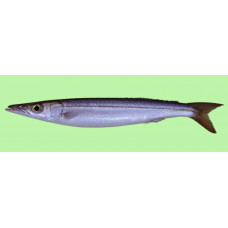Latin name
Sphyraena chrysotaenia
Other name
Yellow-striped barracuda
Identification
Yellow-striped barracudas have a very elongated torpedo-shaped body, typical of barracudas, with two well-divided dorsal fins. They have a large conical head with a large eye, a pointed snout, and a slightly protruding lower jaw. The jaws and palate are lined with large fangs of varying size. The fine scales are cycloidal and the lateral line is almost straight. The preoperculum is covered with scales and its lower posterior margin is concave.
Features of fish fins
The first dorsal fin of these fish has five barb rays, with the first ray being the longest, then the rays gradually decrease in size toward the back. The second dorsal fin begins before the anal fin begins. The tail is conspicuously bifurcated. The pectoral fin is just below the beginning of the first dorsal fin, and the ventral fin is below it.
Fish colouring
Yellowstriped barracudas are brownish-gray above and silver below, with a dark band running from the snout, through the center of the eye, over the base of the pectoral fin to the base of the tail; on the head this band may have a yellowish tinge. The distal portion of the first dorsal and caudal fins are blackish, the second dorsal, pectoral and base of the caudal fins are yellowish.
Distribution
Widespread in the Indo-West Pacific from the Red Sea and Madagascar eastward across the Indian Ocean to China and northern Australia.
Habitat
Tropical marine pelagic-non-rhythmic species. Occupies coastal waters in the pelagic and benthic zones at depths of 10 to 50 meters.
Size
Yellow-striped barracuda have been recorded with standard lengths up to 32 cm, but the average length is 20-25 cm.
Behavior
These fish form large schools.
Food and feeding habits
A piscivorous species, it hunts near the bottom and feeds mainly on gregarious fish such as Sardinella aurita and Engraulis encrasicolus, but can also feed on crustaceans.
Reproduction
The spawning season in the Mediterranean lasts from April to September, or August to November in the central Mediterranean, eggs and fry are planktonic, with juveniles often found in very shallow water. It is a relatively short-lived species, with a maximum age of 5 years. They reach sexual maturity at a total length of 195 mm in females and 197.1 mm in males, usually at 2 years of age.
Fishing
It is currently the most common species of barracuda caught by artisanal fishermen in Lebanon and is 70% more abundant than other species caught on land. It can be caught in coastal waters in significant numbers using purse nets, gill nets and trawls.
Relationship with a person
Harmless.
| Classification | |
| Phylum | Chordata |
| Class | Actinopterygii |
| Squad | Carangiformes |
| Family | Sphyraenidae |
| Genus | Sphyraena |
| Species | S. chrysotaenia |
| Features | |
| Conservation status | Not Evaluated |
| Habitat | Pelagic |
| Life span, years | No information |
| Maximum body weight, kg | No information |
| Maximum length, cm | 32 |
| Sailing speed, m/s | No information |
| Threat to people | Edible |
| Way of eating | Predator |
Yellowstripe barracuda
Tags: yellowstripe barracuda

